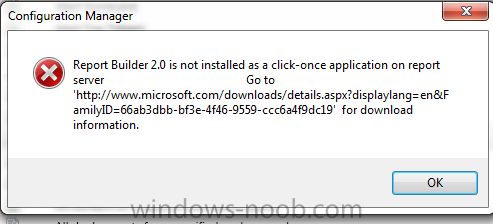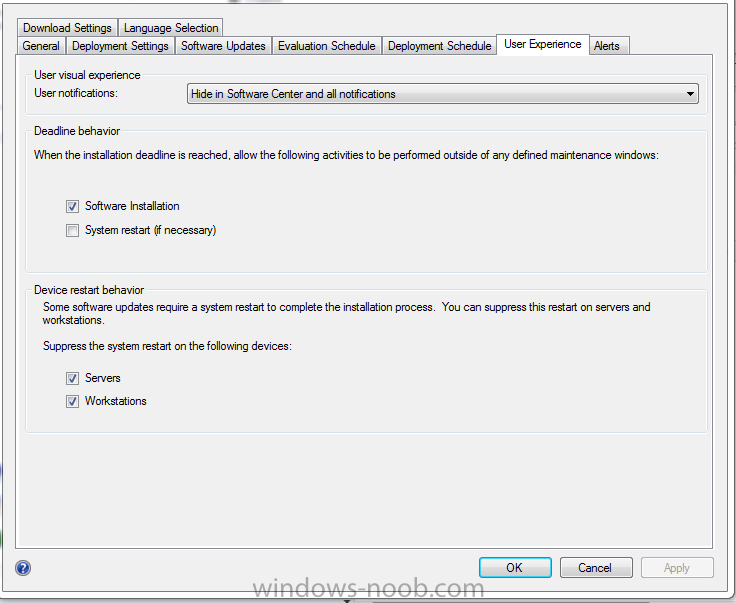
Coenie
Established Members-
Posts
31 -
Joined
-
Last visited
-
Days Won
2
Coenie last won the day on September 21 2012
Coenie had the most liked content!
About Coenie
- Birthday 12/05/1986
Profile Information
-
Gender
Male
-
Location
South-africa
-
Interests
Gaming, technology, social
Coenie's Achievements
Newbie (1/14)
2
Reputation
-
Client not installing Updates from SCCM 2012
Coenie replied to ImaNewb's topic in Configuration Manager 2012
Hi, First I'll check the ruleengine.log through cmtrace, this might give you an indication. -
Hi, I've been sitting with a problem, whereby no updates go through to computers, although it has synchronized properly, and no errors are shown. I've followed the guides on this site step-by-step, and I get no noticeable errors. If I try to send and update using wsus, it goes through fine. This is the case when it comes to auto deployments for anti-virus definition updates, and windows updates, selecting the updates to deploy, creating a software update group, deployment package and deploying it to a collection. What logs can I check, as no errors are reported whatsoever, and the updates simply do not come through, even though they are distributed to the distribution point, etc. Any assistance would be appreciated. Thanks. Coenie
- 2 replies
-
- configmgr 2012
- updates
-
(and 2 more)
Tagged with:
-
Hi, Thanks, UAC is disabled on a domain level, but I have also ran as administrator, and the changes stay in registry, and does not reset. Any other advice would be appreciated.
- 4 replies
-
- report builder
- not installed
- (and 4 more)
-
Thank you, This looks really promising.
- 2 replies
-
- collection
- sccm 2012
-
(and 4 more)
Tagged with:
-
Hi, Thanks, I have changed as shown: But still not getting through. Thanks for the asisstance. Regards. Coenie
- 4 replies
-
- report builder
- not installed
- (and 4 more)
-
Hi, I've come across a Report Builder issue, which is quite baffling. I have installed Report builder 3 , and two in the meantime, and tried the fixes as below, switching between two and three respectively within registry, but no luck I've also tried to launch configmgr as local administrator, and two domain admin accounts on two seperate domains, and still no luck, please advise. http://social.techne...4e-329698a917f2 Thanks. Coenie
- 4 replies
-
- report builder
- not installed
- (and 4 more)
-
Hi, I'm wondering if it is possible to pull in only computer objects that are part of a specific Active directory Security group to a collection, and how such a query will look. Has anyone had to do this in the past, and is it possible? Ultimately we would like to separate computers by departments, and our AD access is such that we cannot create new ou's. Thanks. Coenie
- 2 replies
-
- collection
- sccm 2012
-
(and 4 more)
Tagged with:
-
Coenie started following Sccm 2012/2007 basic troubleshooting of Services and Collection for objects part of a ad group
-
Hi, Did you create a "client settings" template for the systems in question, and under "Remote tools", have you stipulated "Permitted viewers of remote Control and Remote Asisstance"? Thanks. Coenie
-
Hi, I understand you followed the step below? This is not always as effective as it should be, and I found that Group policy is still neccesary to controll this.
-
As far as I've been able to see, is that it requires MDT to enable the functionality of installing Windows 8, and Server 2012. MDT also integrates with sp1 to a certain degree. Think of it as a supplement to WDS.
-
Client Not Installing On Windows 2003 Servers
Coenie replied to tmiller_hockey's topic in Configuration Manager 2012
We had a similar issue, and had to go manually approve Server 2003 systems within the SCCM console. -
Hi, I decided to share our basic space requirements for our SCCM instance, managing approximately 500 computers/servers , as I have not really seen documentation related to this before. Before you start implementing SCCM , it's always good to first pause, and concider the layout. Currently we use three sccm servers, for our purposes, lets call them SCCMA , SCCMB, and SCCMC On SCCMA you would keep a distribution point, and WSUS, and allot of roles, at your discretion . It is important that you have a seperate hard-drive for WSUS , and a Seperate one for your distribution point(Added before installing this role~very important, and set to take preference over your c: drive). Wsus, and your distribution points can easily take up up to 100gb each if fully utilized, and depending on the implementation. It is also important that you leave room for growth on your c: drive for SCCM components ( Please also note, that it is not best practice to have sccm on your C: drive). SCCMB: This server would ideally be used for your SQL database, and maybe some SCCM roles, not that resource hungry. Here it is vital to store your database on a separate hard-drive as to avoid long disc ques, and increase the overall responsiveness of the sccm system. SCCMC: This server is usually perfect for pxe boot functionality, and works perfectly to prioritise pxe traffic, as the server would be dedicated to this role. As with any distribution point role, have a second hard-drive, installed before installing the role, and with enough space to handle operating sstem, boot image, driver , etc storage requirements (This should not go over 50gb neccesarily, depending on implementation) . Note to always assign more space, rather than less. Physical processing power, and memory requirements: Remember, SCCM servers are quite resource intensive, and it is vital that they have good network connectivity to your systems (1gbps is a good thought) . Processing power requirements is usually not that bad, and two virtual processors should usually do the trick, depending on the amount of roles installed on the server. Ram requirements: This is where bottlenecks tend to occur on these systems, and when it's busy polling systems, or performing maintenance it can really utilize your memory. It is vital them to have atleast 12gb ram on each of your sccm servers, also dependant on the roles, and the amount of users the servers would be responsible for. If you can think, or see anything you do not agree with, please don't be hesitant to post.
-
- hard drive
- space requirements
-
(and 4 more)
Tagged with:
-
Hi, I decided to share some dependencies of certain sccm roles, and their related services with all, which might have caused headaches for some. Please add basic troubleshooting steps for common issues if you find some. If wsus does not start up, please ensure the following: Is your sql server service running?(This is only if your WSUS database is hosted on the sccm sql database) If you have difficulties accessing the sccm management console, restart the MSSQL service in services.msc If pxe boot does not work properly, restart the wds role. If wds does not start up, restart the "Server" service, and retry. Note to always set your WDS service to "Delayed start", as to give time for your depaendant services to start up first. As a rule of thumb, when communication issues are experienced, it should be the first step to restart the mssql service. If boot images, etc are inaccessible, ensure that WAIK is installed. When you experience update issues, after a windows update has come through, remember that sometimes hotfixes are available for the WSUS server instance to restore communication.
-
- 1
-

-
- sccm
- troubleshooting
-
(and 2 more)
Tagged with:
-
OK, I'm going to attempt to setup a third system within our sccm infrastructure, and add a distribution point onto that one, with pxe support, waik and WDS, will update on if this resolves the issue, as I'm not planning a reinstall of the entire system. ------------------------------------------------------------ I finally got this sorted by setting up a new site server, and configuring it for pxe, and distributing all os related packages to it. I recreated a task sequence, and so forth, now it works perfectly. So, to sum up, it was my existing distribution point that caused the issues, as I added a hard-drive to it after the innitial installation, and moved the dp to it. Thanks.




